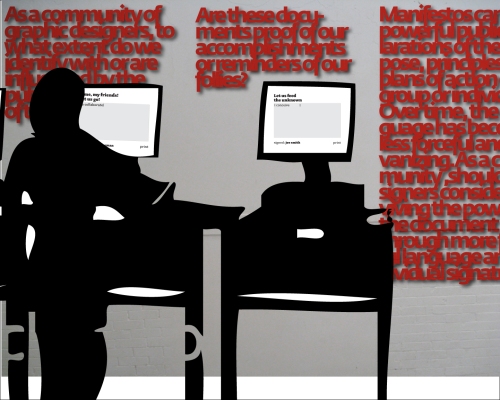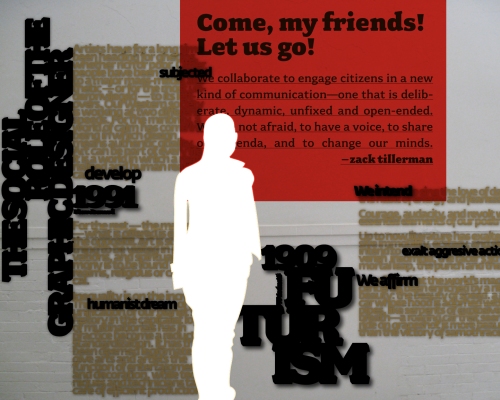The Analysis (see full analysis):
We have chosen 12 manifestos (and some alternates) to incorporate for this project:
They are:
(1909) The Founding and Manifesto of Futurism, F.T. Marinetti // (1921) DADA, Tristan Tzara // (1919) Bauhaus Manifesto, Walter Gropius // (1923) The New Typography, László Moholy-Nagy // (1961) Grid Systems in Graphic Design, Joseph Muller-Brockmann // (1964) First Things First, Ken Garland // (1987) Ten Rules of Good Design, Dieter Rams // (1991) The Social Role of the Graphic Designer, Pierre Bernard // (2000) First Things First // (2000) Incomplete Manifesto (Bruce Mau) // (2008) White Night Before A Manifesto, Metahaven // (2009) The Awesomeness Manifesto, Umair Haque
Alternates / Additions:
(2001) Designers Against Monoculture, Noah Scalin // (2006) Free Font Manifesto, Ellen Lupton
– Reviewed a number of arbitrary (or not) editing processes: first 100 words, every 10th word, selected paragraphs, action words
—————————————————————————————————
The Installation:
– Will be immersive / dimensional / not restricted to walls
– Will include the FIRST 100 WORDS from each of the selected manifestos
– Will highlight ACTION words
– Will be paired according to content, not chronology (example: Futurist (1903) and Social Role of the Graphic Designer (1991)
– Will be laser cut from cardboard of different thicknesses, dimensions and colors (red, black and brown)
– Will have a manifesto manuscript with all manifestos in their entirety.
– Will have lounging area; couch with “manifesto pillows” that you can hug or punch.
—————————————————————————————————
The Input:
–Will have OUR questions at input station to help frame the thinking / discussion (critical, preparatory, highlighting connection, examination) Some examples:
As a community of graphic designers, to what extent do we identify with or are influenced by the public declarations of the past? // Are these documents proof of our accomplishments, or reminders of our follies? // Manifestos can be powerful public declarations of the purpose, principles, or plans of action of a group or individual. Over time, the language has become less forceful and galvanizing. As a community, should designers consider reviving the power of the document through more forceful language and individual signatures? // What does it mean to appreciate the power of the rhetoric of authenticity in our design practices and should we make a public declaration of our ideals, galvanizing our group?
–Will use words and phrases inspired by the language of the manifesto / installation content (both active and passive) to introduce the submision. for example: Come my friends! Let us Go! (We collaborate…) // Let us feed the unknown. (I conceive…)
– Will be signed and projected (and/or maybe printed and affixed to the wallspace)
We look forward to your feedback. love, tania, brooke, ryan and rebecca.






At the moment it’s looking a bit like very cool wallpaper; not sure how much I would read (but there may be a demographic component to this, I admit); what is your intent on that?
Also, the wallpaper effect suggests a commercial application: (seriously) t-shirts, totes, those pillows! You could make some money…….
Thanks – those are great thoughts. Hopefully you will read the book that will accompany these. You are right, this is sort of like wallpaper. And, yes! we should make t-shirts – that is a great idea.